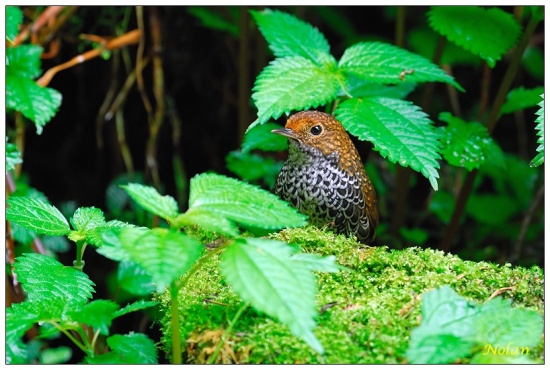(picture added) |
(prepare to rename) |
||
| Line 1: | Line 1: | ||
| − | '''Alternative name: Taiwan | + | '''Alternative name: Taiwan Wren-Babbler''' |
[[Image:C4508 Pygmy Wren Babbler.jpg|thumb|550px|right|Photo by {{user|Nolan.Hwang|Nolan.Hwang}}<br />Alishan, [[Taiwan]]]] | [[Image:C4508 Pygmy Wren Babbler.jpg|thumb|550px|right|Photo by {{user|Nolan.Hwang|Nolan.Hwang}}<br />Alishan, [[Taiwan]]]] | ||
;[[:Category:Pnoepyga|Pnoepyga]] formosana | ;[[:Category:Pnoepyga|Pnoepyga]] formosana | ||
| Line 18: | Line 18: | ||
==Taxonomy== | ==Taxonomy== | ||
This is a [[Dictionary_M-O#M|monotypic]] species.<br /> | This is a [[Dictionary_M-O#M|monotypic]] species.<br /> | ||
| − | It was considered conspecific with [[Pygmy | + | It was considered conspecific with [[Pygmy Cupwing]] or with [[Scaly-breasted Cupwing]] in the past. |
==Habitat== | ==Habitat== | ||
| − | Floor and understorey of broadleaf evergreen forest, mossy boulders, fallen logs, forest ravines, dense fern growth. Generally found between 200 and 3050m. Found in similar habitat like [[Scaly-breasted | + | Floor and understorey of broadleaf evergreen forest, mossy boulders, fallen logs, forest ravines, dense fern growth. Generally found between 200 and 3050m. Found in similar habitat like [[Scaly-breasted Cupwing]] but on lower altitudes.<sup>[[#References|1]]</sup> |
==Behaviour== | ==Behaviour== | ||
More often heard than seen. Forages on the ground, sometimes up to 2m in trees, feeding on ants, other insects and spiders.<br /> | More often heard than seen. Forages on the ground, sometimes up to 2m in trees, feeding on ants, other insects and spiders.<br /> | ||
| Line 30: | Line 30: | ||
{{Ref}} | {{Ref}} | ||
==External Links== | ==External Links== | ||
| − | {{GSearch|Pnoepyga | + | {{GSearch| "Pnoepyga formosana" {{!}} "Taiwan Cupwing" {{!}} "Taiwan Wren Babbler" {{!}} "Taiwan Wren-Babbler"}} |
| − | + | {{GS-checked}}1<br /><br /> | |
[[Category:Birds]][[Category:Pnoepyga]] | [[Category:Birds]][[Category:Pnoepyga]] | ||
Revision as of 01:22, 6 September 2023
Alternative name: Taiwan Wren-Babbler
- Pnoepyga formosana
Identification
With 7.5 - 9cm a tiny, almost tailless Babbler with two morphs.
Pale morph:
- From crown to rump greyish olive-brown with dark scaling
- Head side greyish olive-brown too, ear-coverts with pale shaft streaks
- Chin and throat white with narrow scaling
- Breast and belly white with scaly effect
Dark morph:
- Darker olive brown above
- White below replaced with ochre
Distribution
Endemic to Taiwan.
Common in parts of its range.
Taxonomy
This is a monotypic species.
It was considered conspecific with Pygmy Cupwing or with Scaly-breasted Cupwing in the past.
Habitat
Floor and understorey of broadleaf evergreen forest, mossy boulders, fallen logs, forest ravines, dense fern growth. Generally found between 200 and 3050m. Found in similar habitat like Scaly-breasted Cupwing but on lower altitudes.1
Behaviour
More often heard than seen. Forages on the ground, sometimes up to 2m in trees, feeding on ants, other insects and spiders.
The nest is a ball of moss or a built-in structure made of long strands of green moss, the inner part formed to a cup. It's placed in moss, orchids, ferns or creepers hanging down from large trees, close to the ground. Lays 2 - 6 eggs.
Resident species.1
References
- Del Hoyo, J, A Elliott, and D Christie, eds. 2007. Handbook of the Birds of the World. Volume 12: Picathartes to Tits and Chickadees. Barcelona: Lynx Edicions. ISBN 978-8496553422
- Rasmussen, PC and JC Anderton. 2005. Birds of South Asia: The Ripley Guide. Barcelona: Lynx Edicions. ISBN 978-8487334672
- Clements, JF. 2010. The Clements Checklist of Birds of the World. 6th ed., with updates to December 2010. Ithaca: Cornell Univ. Press. ISBN 978-0801445019. Spreadsheet available at http://www.birds.cornell.edu/clementschecklist/Clements%206.5.xls/view
Recommended Citation
- BirdForum Opus contributors. (2024) Taiwan Cupwing. In: BirdForum, the forum for wild birds and birding. Retrieved 29 April 2024 from https://www.birdforum.net/opus/Taiwan_Cupwing
External Links
GSearch checked for 2020 platform.1




